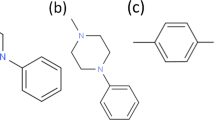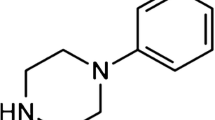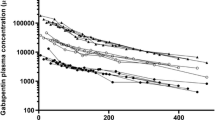Abstract
Purpose. The transepithelial transport characteristics of theantihistamine, diphenhydramine, were studied in human intestinal Caco-2 cellmonolayers to elucidate the mechanisms of its intestinal absorption.
Methods. The transepithelial transport and the cellular accumulationof diphenhydramine were measured using Caco-2 cell monolayersgrown in Transwell chambers.
Results. The transepithelial transport of diphenhydramine from theapical to basolateral side was saturable, and the flux and cellularaccumulation of diphenhydramine were dependent on the apicalextracellular pH (pH 7.4 > 6.5 > 5.5). Transport and accumulation ofdiphenhydramine from the apical side were inhibited by anotherantihistamine, chlorpheniramine, while typical substrates for the renal organiccation transport system such as tetraethylammonium, cimetidine andguanidine had no effect. The transepithelial transport and cellularaccumulation of diphenhydramine from the basolateral side were alsopH-dependent and inhibited by chlorpheniramine. In addition, intracellulardiphenhydramine preloaded was preferentially effluxed to the apicalside, suggesting the involvement of the secretory pathway indiphenhydramine transport. Furthermore, diphenhydramine uptake from boththe apical and basolateral sides was stimulated by preloadingmonolayers with chlorpheniramine (trans-stimulation effect).
Conclusions. Transepithelial transport of diphenhydramine acrossCaco-2 cells is mediated by pH-dependent, specific transport systemsthat exist in both the apical and basolateral membranes.
Similar content being viewed by others
REFERENCES
T. Tan, M. Kuramoto, T. Takahashi, H. Nakamura, Y. Nakanishi, Y. Imasato, and H. Yoshimura. Characteristics of the gastrointestinal absorption of morphine in rats. Chem. Pharm. Bull. 37:168–173 (1989).
S. M. Kuo, B. R. Whitby, P. Artursson, and J. A. Ziemniak. The contribution of intestinal secretion to the dose-dependent absorption of celiprolol. Pharm. Res. 11:648–653 (1994).
I. Tamai, A. Saheki, R. Saitoh, Y. Sai, I. Yamada, and A. Tsuji. Nonlinear intestinal absorption of 5-hydroxytryptamine receptor antagonist caused by absorptive and secretory transporters. J. Pharmacol. Exp. Ther. 283:108–115 (1997).
H. Lennernäs and C.-G. Regå rdh. Dose-dependent intestinal absorption and significant intestinal excretion (exsorption) of the β-blocker pafenolol in the rat. Pharm. Res. 10:727–731 (1993).
T. Koudriakova, E. Iatsimirskaia, S. Tulebaev, D. Spetie, I. Utkin, D. Mullet, T. Thompson, P. Vouros, and N. Gerber. In vivo disposition and metabolism by liver and enterocyte microsomes of the antitubercular drug rifabutin in rats. J. Pharmacol. Exp. Ther. 279:1300–1309 (1996).
T. Gramatté, R. Oertel, B. Terhaag, and W. Kirch. Direct demonstration of small intestinal secretion and site-dependent absorption of the β-blocker talinolol in humans. Clin. Pharmacol. Ther. 59:541–549 (1996).
K. Turnheim and F. O. Lauterbach. Absorption and secretion of monoquaternary ammonium compounds by the isolated intestinal mucosa. Biochem. Pharmacol. 26:99–108 (1977).
K. Turnheim and F. Lauterbach. Interaction between intestinal absorption and secretion of monoquaternary ammonium compounds in guinea pigs· a concept for the absorption kinetics of organic cations. J. Pharmacol. Exp. Ther. 212:418–424 (1980).
Y. Miyamoto, V. Ganapathy, and F. H. Leibach. Transport of guanidine in rabbit intestinal brush-border membrane vesicles. Am. J. Physiol. 255:G85–G92 (1988).
S. Hsing, Z. Gatmaitan, and I. M. Arias. The function of Gp170, the multidrug-resistance gene product, in the brush border of rat intestinal mucosa. Gastroenterology 102:879–885 (1992).
H. Koepsell. Organic cation transporters in intestine, kidney, liver, and brain. Annu. Rev. Physiol. 60:243–266 (1998).
L. Zhang, C. M. Brett, and K. M. Giacomini. Role of organic cation transporters in drug absorption and elimination. Annu. Rev. Pharmacol. Toxicol. 38:431–460 (1998).
P. Artursson and R. T. Borchardt. Intestinal drug absorption and metabolism in cell cultures: Caco-2 and beyond. Pharm. Res. 14:1655–1658 (1997).
I. J. Hidalgo, T. J. Raub, and R. T. Borchardt. Characterization of the human colon carcinoma cell line (Caco-2) as a model system for intestinal epithelial permeability. Gastroenterology 96:736–749 (1989).
K. Inui, M. Yamamoto, and H. Saito. Transepithelial transport of oral cephalosporins by monolayers of intestinal epithelial cell line Caco-2: specific transport systems in apical and basolateral membranes. J. Pharmacol. Exp. Ther. 261:195–201 (1992).
H. Saito and K. Inui. Dipeptide transporters in apical and basolateral membranes of the human intestinal cell line Caco-2. Am. J. Physiol. 265:G289¶ G294 (1993).
S. Matsumoto, H. Saito, and K. Inui. Transcellular transport of cephalosporins in human intestinal epithelial cells, Caco-2: interaction with dipeptide transport systems in apical and basolateral membranes. J. Pharmacol. Exp. Ther. 270:498–504 (1994).
H. Mizuuchi, T. Katsura, H. Saito, Y. Hashimoto, and K. Inui. Transport characteristics of diphenhydramine in human intestinal epithelial Caco-2 cells: contribution of pH-dependent transport system. J. Pharmacol. Exp. Ther. 290:388–392 (1999).
D. M. Paton and D. R. Webster. Clinical pharmacokinetics of H1-receptor antagonists (the antihistamines). Clin. Pharmacokinet. 10:477–497 (1985).
A. M. de Roos, R. F. Rekker, and W. T. Nauta. The base strength of substituted 2-(diphenylmethoxy)-N,N-dimethylethylamines. Arzneim. Forsch. 20:1763–1765 (1970).
H. Saitoh and B. J. Aungst. Possible involvement of multiple P-glycoprotein-mediated efflux systems in the transport of verapamil and other organic cations across rat intestine. Pharm. Res. 12:1304–1310 (1995).
K. Arimori and M. Nakano. Drug exsorption from blood into the gastrointestinal tract. Pharm. Res. 15:371–376 (1998).
F. Thiebaut, T. Tsuruo, H. Hamada, M. M. Gottesman, I. Pastan, and M. C. Willingham. Cellular localization of the multidrug-resistance gene product P-glycoprotein in normal human tissues. Proc. Natl. Acad. Sci. USA 84:7735–7738 (1987).
J. Hunter, M. A. Jepson, T. Tsuruo, N. L. Simmons, and B. H. Hirst. Functional expression of P-glycoprotein in apical membranes of human intestinal Caco-2 cells. Kinetics of vinblastine secretion and interaction with modulators. J. Biol. Chem. 268:14991–14997 (1993).
J. Hunter, B. H. Hirst, and N. L. Simmons. Drug absorption limited by P-glycoprotein-mediated secretory drug transport in human intestinal epithelial Caco-2 cell layers. Pharm. Res. 10:743–749 (1993).
J. Karlsson, S.-M. Kuo, J. Ziemniak, and P. Artursson. Transport of celiprolol across human intestinal epithelial (Caco-2) cells: mediation of secretion by multiple transporters including P-glycoprotein. Br. J. Pharmacol. 110:1009–1016 (1993).
T. Ito, I. Yano, K. Tanaka, and K. Inui. Transport of quinolone antibacterial drugs by human P-glycoprotein expressed in a kidney epithelial cell line, LLC-PK1. J. Pharmacol. Exp. Ther. 282:955–960 (1997).
K. Tanaka, M. Hirai, Y. Tanigawara, K. Ueda, M. Takano, R. Hori, and K. Inui. Relationship between expression level of P-glycoprotein and daunorubicin transport in LLC-PK1 cells transfected with human MDR1 gene. Biochem. Pharmacol. 53:741–746 (1997).
K. Inui and M. Okuda. Cellular and molecular mechanisms of renal tubular secretion of organic anions and cations. Clin. Exp. Nephrol. 2:100–108 (1998).
U. Laforenza, M. N. Orsenigo, and G. Rindi. A thiamine/H+ antiport mechanism for thiamine entry into brush border membrane vesicles from rat small intestine. J. Membr. Biol. 161:151–161 (1998).
Author information
Authors and Affiliations
Rights and permissions
About this article
Cite this article
Mizuuchi, H., Katsura, T., Hashimoto, Y. et al. Transepithelial Transport of Diphenhydramine Across Monolayers of the Human Intestinal Epithelial Cell Line Caco-2. Pharm Res 17, 539–545 (2000). https://doi.org/10.1023/A:1007560731098
Issue Date:
DOI: https://doi.org/10.1023/A:1007560731098




